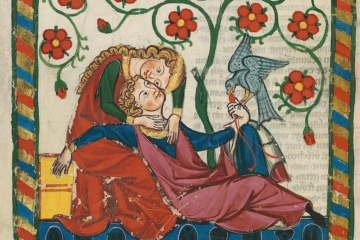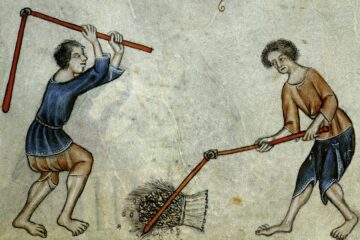The past two centuries have seen an increase in the number of Holy Orders within the Catholic Church. As the Papal authority in Rome wanes, the various sects of Catholicism have sought to consolidate their clerical and monastic traditions into these orders. There are different types of holy orders; some focus on monastic life, some focus on the serving clergy, while others mix the two. All of the following orders have been approved by Pope Alexander V. The most popular Holy Orders of the time are:
The Benedictine Order
The Benedictine Order is the oldest continuous monastic order and mostly focuses on the lives of monks. St. Victor’s Monastery in Rosewood follows the tenants of the Benedictine Order. They prize the value of manual labor combined with strenuous mental activity. By working both body and soul, balance may be achieved. They show great admiration to the diocesan clergy and believe in following their instructions. Benedictine communities are tightly-knit and focus on a shared sense of fraternity and paternal love for all members. Of all virtues, they value obedience the most. The name is derived from the life of St. Benedict of Nursia. It is most popular in France, Spain, and Italy. They are recognizable by their black attire.
The Dolomitian Order
The Dolomitian Order was founded near the turn of the millennium and is a monastic order which aims to promote a secluded life for its monks and nuns. Dolomitians live alone in secluded religious homes and are encouraged to ponder and live a simple life. They specifically ban the use of musical instruments, so they only allow singing, and usually only when it is in service to the church. Sobriety is encouraged and while a solitary life is part of their identity, they are also encouraged to help local communities if they need it. Their most valued activity is the preservation of vernacular stories and texts and their translation into Latin. Of all virtues, they value simplicity the most. The name is derived from the Dolomite Alps north of Venice, where the order was first established. It is most popular in the north of Italy and part of the Balkans. They are recognizable by their white attire.
The Baptistine Order
The Baptistine Order was founded around 1100. It is a holy order practiced by both monks and diocesan clergymen. Baptistines swear an oath of poverty upon joining the order, meaning they live a life devoted to the community. They are charitable and servile, meaning they will devote themselves entirely to the community they belong to. Usually, the only “compensation” they require is food and a place to sleep and study. They don’t value contemplation, but they are supporters of passionate preaching, especially to large groups of people. Of all virtues, they value poverty the most. The name is derived from the life of St. Baptiste of Aqvintia. It is popular across Europe. They are recognizable by their white attire, covered by a black cloak.
The Roseate Order
The Roseate Order is a religious order that came into being after the Fifty Years’ War had ended in Rosewood. It is a holy order mostly intended for the diocesan clergy. Those who are part of this order are taught that poverty is not virtuous on its own, but that its virtue comes as a result of sharing your wealth with those who need it the most. Roseate members place great significance on the pursuit of divine revelation, the study of the Bible in hopes of acquiring profound wisdom. Their most controversial characteristic is their love for the human form, as they believe it to be God’s greatest creation, thus leading the Roseateans to allow women to become ordained within the clergy, a practice already popular in Rosewood. Their views are extremely popular among the common people since they are also encouraged to send regular aid to nearby communities. Of all virtues, they value love the most. The name is derived from the Capital of France, Rosewood, where the order was first established. It is popular in France, parts of Spain, the Low Countries, Ireland, and Scotland. They are recognizable by their dark brown attire.
The Ghislainic Order
The Ghislainic Order is an order of monks formed sometime during the 12th century. They are a fraternity of monks who aim to halt the spread of anti-dogmatic thought within Europe. They are fervently opposed to vernacular languages and regional traditions. Instead, they promote the church dogma by teaching Latin in settlements and general Christian ethics, which is based on Abrahamic morality. They follow the Old Testament closely and are not strangers to burning translated texts or preserved pieces of vernacular history. They also fight against pagan additions to the Christian faith. Among the members of their order, there is little animosity towards the other sects of Christianity, even the other Abrahamic religions. Of all virtues, they value zeal the most. The name is derived from St. Gislain of Dover, who was martyred by the Anglican Church. It is popular in Ireland, Bretonia, and northern Italy. They are recognizable by their grey attire.
The Evanite Order
The Evanite Order was founded around 1200 in the lands of Bavaria. It is not exclusive to either clergy, but it is an order mostly favored by women. Members of the Evanite order venerate the story of Genesis, specifically the role of Eve in the history of man. Besides Eve, they refer to Sarah, Abrahams’s wife, and Mary, the Mother of Christ. They are mostly comprised of women and therefore deal mostly with women’s issues. Among their most important duties is teaching proper motherhood to young girls, helping them understand pregnancy and their body changes as they come of age, teaching women Biblical morality, defending women during trials, serving as midwives, and caring for orphaned children as well as the elderly. The Order is a fringe one, but the Church has canonized them for their submissive stance towards the position of women, which comes as a welcome change when compared to the social currents present in and around Rosewood. There are women in the Evanite Order who believe that women should be treated better, but they are few in number since the order itself doesn’t promote pondering or contemplation. Some men are in the Order, but they are mostly at the highest positions. Of all virtues, they value compassion the most. The name is derived from both the Biblical mother of Abel, but also Mother Eva of Bavaria who founded the Order. It is popular in France and the Holy Roman Empire. They are recognizable by their brown attire, covered by a white cloak.


